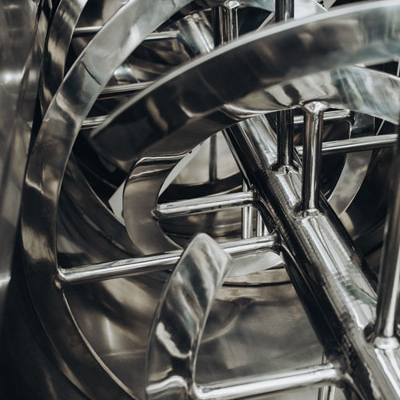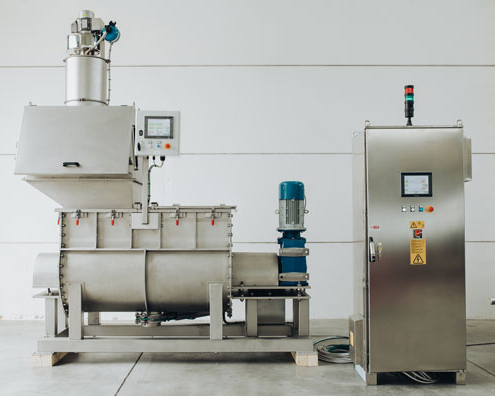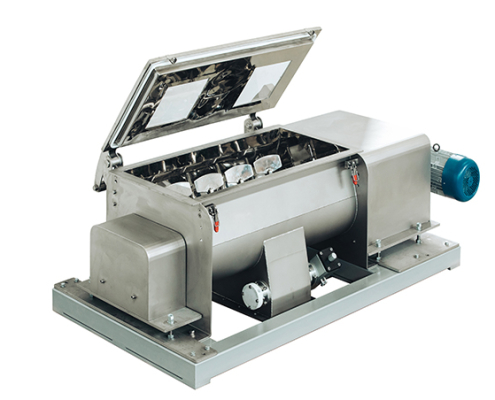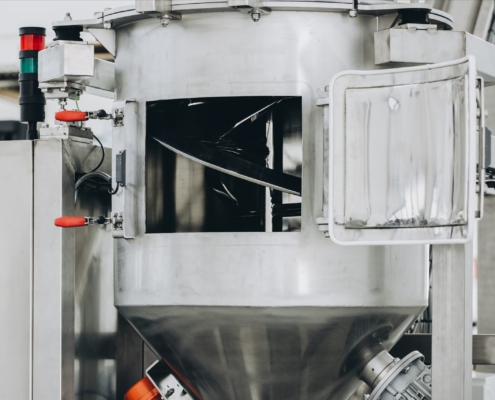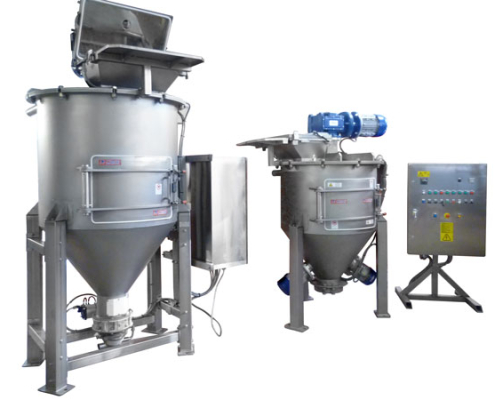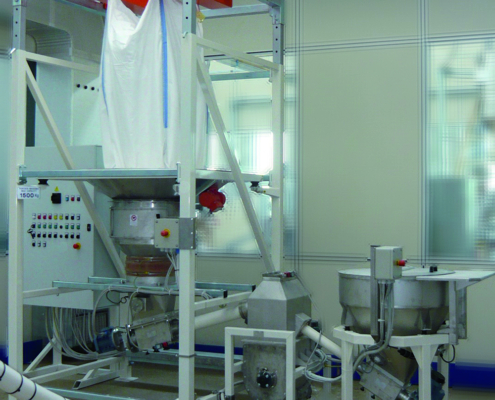The food industry as well as the pharmaceutical and chemical industries require high performance powder blending to be integrated into bulk solids processing.
The complexity of the mixing process (given by the infinite variety of ingredients and industrial standards) requires the advice of an expert to choose the best powder mixing equipment.
Industrial powder mixers can be divided into two main categories, depending on the machine’s operating cycle:
- Batch mixers
- Continuous mixers
Let’s see what is the difference between a batch mixer and a continuous mixer: in a batch mixer, after loading a predetermined quantity of products, the mixing cycle will start for a set time. At the end of the set operating time, the mixture obtained is discharged from the outlet mouth through an electro-pneumatic valve. The ingredients for one batch are loaded, according to a defined sequence or simultaneously, mixed, and discharged before the next batch. This allows for complete control of mixture and output.
In continuous mixing processes the ingredients are charged continuously and they are usually used for a single high-volume product. The main advantages of these kind of powder mixers are the high capacity and production rates, along with the lower mixing time.
Other key factors to select the right powder mixer
Powder characteristics
Particles size, texture, flowability and stickiness are the main material elements to consider when we design a powder mixing equipment
Hygiene requirements
In many cases, industrial standards impose the use of food grade construction materials and stringent cleaning requirements to avoid cross contamination
Processes requirements
They can vary from the gentle blending of fragile ingredients to the powder agglomeration and deagglomeration, and consequently they require different powder mixing techniques
Space requirements
When a new machinery is inserted into an existing plant, the available spaces become an element to be considered in the design of the powder mixer, for correct integration with the downstream and upstream processes
Batch mixers
Batch mixers can be divided into two main types:
- Horizontal mixers
- Vertical mixers
Horizontal mixers
Gimat’s horizontal ribbon mixers are made of thick plates of painted carbon steel or stainless steel AISI 304 or 316 with surface treatment fit for use.
Mixing is done gently and evenly without overheating the product mixed, thanks to the special four-way and four cross-flow ribbon, with central drain. The low peripheral speed makes these mixers particularly suitable for applications in hazardous areas in accordance with ATEX regulations.
The direct transmission (by means of a bevel gear motor, integrated with elastic coupling with torsional flexibility) ensures a high performance of the entire kinematic chain and extremely quiet operation.
The elastic coupling allows to damp vibrations and reduce the maximum impact load, resulting to all effects in a damping effect of the rotary motion.
Twin-shaft paddle mixers
Twin-shaft paddle mixers (always with a horizontal axis) come into play in cases where extremely accurate mixing is required, in situations of mixing ratios or particle sizes that are very different, thanks to the principle of the centrifugal handling of individual particles.
They consist of 2 counter-rotating shafts each with a set of appropriately configured paddles welded to them. Given very fast mixing (1- 2 min max) they enable high hourly throughputs of mixed product when loaded automatically.
The powders to be mixed arrive automatically previously dosed at the mixer’s loading inlet. The mix is discharged into a buffer of equal content to optimize the No. of cycles per hour.
Vertical mixers
The vertical mixers are characterized by a conical body with a vertical axis mixing blade.
The rotation of the helicoid creates an upward flow of product on the peripheral portion of the mixing chamber and descending in the center.
The rotation of the mixing shaft is carried out by means of a geared motor unit with single bearing support on the top.
These vertical blenders are particularly targeted at the food industry and pharmaceutical industry, as they ensure good mixing and the absence of residues during emptying.
In addition, the particular shape of the conical mixer body, allows a high quality of interior finish and ease of cleaning. They are also suitable for being placed under vacuum should they be loaded pneumatically.
As in the case of ribbon blenders, the mixing also occurs in a gentle and homogeneous manner without overheating the mixed product.
The low peripheral speed makes these mixers particularly suitable for applications in hazardous areas in accordance with ATEX regulations.
Continuous mixers
For continuous mixing processes we design and manufacture dosing hoppers or dosing machines with possibly integrated a continuous paddle mixer
Dosing hoppers incorporate powder storage, dosing of the various components, conveying and mixing in the same system. They are also ideal for carrying out mixing of 2 or 3 or up to 4 products in powder, granule or grinded form.
The individual components come from the bag emptying stations or bulk bag unloaders and by means of volumetric or gravimetric feeders are dosed in a continuous mode.
Dosed products go into a continuous paddle mixer (if present) and transferred to the loading point of a Flexible Spiral Conveyor which picks up the already dosed products and further mixes them during transport to the discharge/destination point.
The integrated system thus designed allows for very high flow rates of mixed product with a good degree of mixing.

